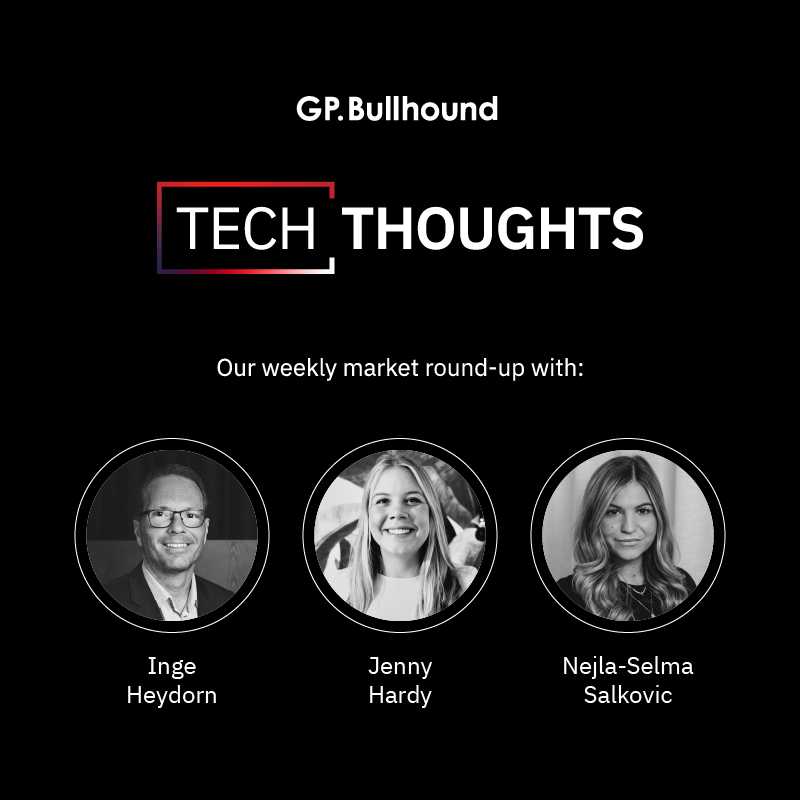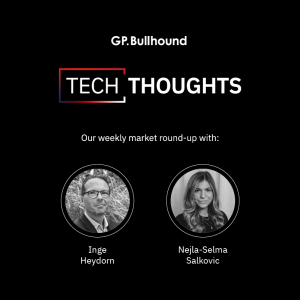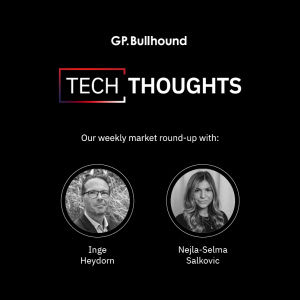Tech Thoughts Newsletter – 27 January 2023.

Conclusion: The first big week of results in tech and as we suspected, even if reported results were robust, CEOs and CFOs struck a cautious tone – particularly around the guidance. We think that’s the message we’re likely to hear from big tech reporters next week too. We’ve seen employee cuts across the board so far this year in tech – coming out with a bullish outlook just a few weeks later is probably not on the cards.
Intel (which we don’t own) showed what happens when a company doesn’t execute in a tough industry environment – a complete disaster. Semis is clearly going through a very tough industry correction on the consumer side, while autos (where we’re exposed) so far remains the bright spot of demand.
It’s interesting to us that most of the big single day up moves in tech so far this year have been driven by cost cutting (Alphabet), activists (Salesforce), prices increases (Shopify)… Hopefully tech isn’t the new telcos..!
Portfolio: we trimmed our exposure to Microsoft before it reported at the start of the week, as we felt the risk/reward, particularly after the headcount reduction, was skewed to the downside.
Software – long term drivers of digitisation intact, short term caution around spend “optimisation”
- Microsoft (owned) headline results were fine but the call included an effective guide down, and commentary that the environment had weakened in December.
- They’re clearly exposed to the weak PC market too, which sounds still very bleak and there are have their own supply issues – all of this means the old soft “double digit” top line guide looks quite a bit harder to get to.
- In particular Azure (which has really become the most important number in quarterly results) is expected to decelerate a further 4-5 points from the mid 30s rate it exited December at (so more like a 7-8ppt qtr/qtr slowdown). That seems to be driven by spend and workload optimisation. Clearly there is more scrutiny from customers on spend levels, as well as longer sales cycles (especially for new products)
- Longer term, there was a brighter message that tech spend as % of GDP goes higher over time (there is a definite defense from Nadella that the optimisation piece is a temporary pause..).
- The comments go back to the bundling Satya talked a lot about at the Ignite conference last year. It’s something to watch out for for the broader software space and we think we’ll see more spend consolidation in software. It’s not hard to imagine budgets over the last several years have led to easy sign offs, and many companies will almost certainly have multiple vendors offering solutions to the same problems, or niche one product solutions that could be replaced by a broader product offering.
- In the portfolio we’re positioned in those best-in-class software stocks which we think at the margin should benefit from consolidation of spend given their platform-like solutions – more comments on ServiceNow, which had a stellar result, below.
- Elsewhere for us commentary around datacentre investments increasing sequentially (hopefully helpful for the broader ecosystem)
- ServiceNow (owned) reported really solid results in our view – subscription revenues +27.5% yr/yr cc just ahead of the guide, FCF and operating margin both ahead too.
- Q1 guidance looks good and for 2023 they’re guiding for 23% subs revs growth vs 21% consensus – there really weren’t a lot of holes to pick in this set of results.
- The call and commentary was typically bullish from Bill McDermott around net renewal rates as well as net new business, and still strong underlying demand.
- They’re also speaking to seeing a repriortisation of spend which is benefiting them as the platform play (and to be fair, these results definitely give credence to that – as above it’ll be interesting to see if we see that weakness the other side with some of the nichey solutions where we’re more cautious).
- We felt the initial stock reaction was very harsh and it rightly recovered on the call – it’s a business which isn’t cutting guidance, and isn’t cutting its workforce.. It felt a bit harsh not to be rewarded for that (although as we noted last week, Bill McDermott had maybe been out being a bit too bullish in Davos..)
- SAP was a small miss – the key cloud revenue number for Q4 came in 2% below consensus, and given they had shifted up their guide at the end of October – and it in turn only just come in within that range – so consistent with Microsoft that the environment likely weakened towards the end of the year.
- SAP is a slow moving ship, which is good on the downside – this isn’t a disaster. But it’s not immune to the macro and the reality is the growth suggests it’s more of a static part of the core enterprise solution rather than gaining share in peripheral cloud applications. But no doubt it is absolutely executing in this environment.
- They also announced they’re cutting 2.5% of their workforce and will sell out of their Qualtrics stake (SAP selling hyper growth – tech really is different!)
Intel’s shocker deserves a set of bullets on its own – What happens when a company defined by tech leadership falls behind…
- Intel (not owned) was an absolute disaster. We opened the release and thought at first we’d mistakenly opened the wrong one, because the numbers made no sense, alas they really were that bad.
- Q4 revenue missed slightly (not terrible) but the Q1 guidance of $11bn was the real shocker. This will be the lowest revenue dollar amount since 2010. Gross margins dropping to 39% in Q1 – and that’s with an accounting benefit – adjusted for that they’re at 36% – they should be well over 50.
- Obviously we know the PC market has been and is still terrible (they’re blaming a large inventory correction) and the datacentre market is weakening. Intel can’t get away from that, but these results show much more than that – there are clearly some very Intel specific issues at play.
- We think the Sapphire Rapids ramp (on its 10nm process node) is hurting gross margin given lower capacity utilisation. This also likely hurt Q4 datacentre revenues as customers held off for the new release.
- At the same time, all the performance comparisons we’ve seen suggest the product performance is still significantly behind AMD’s Genoa. The reality is that AMD’s Genoa performance and energy efficiency gains have totally trumped Intel for the past several years and since 2019 AMD has nearly doubled its market share in servers.
- We worry a bit whether part of Intel’s guide is it deciding to slash pricing (given the inferior product performance). That wouldn’t be good news for the market or in the short term for AMD. Long term it feels like there’s no real let up in the continued outperformance of AMD and market share shift within x86 away from Intel.
- We also think the bad results are potentially compounded by huge misplanning from Intel. Earlier this year they held a PC TAM day, which at the time felt quite out of touch with the core market – and now looks fairly silly. They projected the long-term PC TAM to be 300m annual units, and 270m-295m units in 2023 – which is frankly laughable, and if they were/are planning for this (the inventory on their balance sheet increased again qtr/qtr) – this may not be a one off shocker..
Semis – consumer inventory correction deeper and longer, while auto remains robust
- We know there’s an inventory correction going on in semis, and the market has discounted this somewhat in company valuations – the question really is how long and how deep it will be, whether it will really bottom in Q2 (and whether we’ll really get the V shaped recovery) – and if not whether this needs to be discounted further.
- We believe that in consumer semis, there is a risk the downturn is much deeper than the market has currently embedded into forecasts or valuations and we continue to not hold any direct mobile/PC semis stocks.
- Inventory levels are still high – we heard that from UMC last week – even at 70% utilisation levels its inventory is still going higher.
- On the other side, autos, and specifically power semis going into the autos space, remains an area of structural shortage, where high demand outstrips supply.
- STMicro (not owned but a good read to Infineon and NXP which we do own) – was good. Q4 came in +2.4% qtr/qtr, a bit better than expected, and Q1 is guided for a 5% sequential decrease, where consensus was closer to 10%. What’s positive for us is that it’s the auto segment driving the growth.
- They’re spending $4bn capex this year (from a high level of $3.5bn last year – we had expected spend to drop) which is not an insignificant number and speaks to the auto/industrial IDM spending we’ve pointed to for the semicap space (and which ASML spoke to – more on that in our semicap comments below)
- We heard a similar message from Texas Instruments. Q4 results were in line with the (slightly damp) guide, -11% qtr/qtr and the Q1 guide was a bit below consensus, implying the yr/yr trends continues to decelerate. Key (and again good news for us with NXP and Infineon) is no signs of weakness yet in auto which bucked the trend of qtr/qtr declines and was up mid single digits.
- Wolfspeed’s SiC business is still seeing strong demand for autos, while 5G demand for RF power amplifiers are weak, and capacity isn’t easily fungible between the two – it will continue to be a tough business to manage and with STM now targeting 40% of its SiC to be internally produced by the end of 2024, we think it’s an industry which, while expanding rapidly as a result of increased applications, will see increasing competition over time – we much prefer to be further up the value chain with Infineon
- Seagate provided a better picture of inventory at its US data storage (cloud and enterprise) customers – saying customers had worked down the higher HDD inventory that had built up during the pandemic.
Semicap equipment – memory spend a drag, ASML bucking the trend
- ASML (owned)results showed it as really the standout in semicap – in a market which will be down 20% this year, its sales will be up 25%.
- Bookings weren’t quite as robust as last quarter, but book to bill around 1 is still fine (with most semis expected to fall below, more so as we go through the year).
- In the commentary they did acknowledge the weaker macro/rising inventories and commented that their machines are seeing lower utilisation at customers.
- However, the benefit ASML is seeing is still that their customers are focused on the longer term strategic capacity builds and tech leadership. The reality is that so far, customers are pretty firmly expecting to see a recovery in H2 – given the lead time of ASML’s machines, it makes no sense to risk going to the back of the queue. This can change, and we’ll be on the lookout for signs of that, but for now – with a backlog of EUR 40bn and with demand still higher than they can supply, you have to think ASML is certainly one of the tech businesses with the highest visibility right now.
- KLA (owned) – December quarter results were good, while the March quarter was guided to be down ~20% qtr/qtr – slightly better than LAM but still below expectations. While the guide is weak, we believe there’s an element of pull forward of shipments.
- They give a good amount of detail around the specific tools and processes shipped and we can see patterning systems driving the bulk of growth – that specifically relates to EUV lines so reflecting back ASML’s strong results and the long term tech upgrade driver
- KLA with its higher logic exposure should be more resilient – and we still expect it to outperform the market this year.
- LAM Research (owned – but we decreased our position into the quarter given the relatively larger memory exposure), like KLA reported solid December quarter sales but a March quarter guide of -25% qtr/qtr was weaker.
- Semicap is absolutely seeing a pullback in demand from memory – which will decline more than the market this year. We think it’s also being more impacted by China restrictions – CXMT and YMTC both had restrictions on their 17nm DRAM / 128 layer NAND. Interestingly LAM and KLA gave opposite views of which of DRAM or NAND spend would be more resilient – that in itself probably speaks to the low visibility in both markets!
- Our view is absolutely that 2023 will be a reset year driven by memory. But these are all businesses with high free cash flow generation, and where valuations and forecasts we think have already largely embedded that in forecasts and valuation.
- And where, longer term, investment projects driven by tech sovereignty and politics and at the trailing edge driven by structural shortages and high demand will continue to support demand.
For weekly insights on the latest market updates, please subscribe to our Tech Thoughts podcast.
For more information about Tech Thoughts, please visit https://www.gpbullhound.com/tech-thoughts/.
We provide investors with access to category leading technology companies, globally. Our assets under management have a total value of more than €1bn, and our limited partners include institutions, family offices and entrepreneurs. Learn more about our funds here.
Enquiries
For enquiries, please contact:
Inge Heydorn, Partner, at inge.heydorn@gpbullhound.com
Jenny Hardy, Portfolio Manager, at jenny.hardy@gpbullhound.com
Nejla-Selma Salkovic, Analyst, at nejla-selma.salkovic@gpbullhound.com
About GP Bullhound
GP Bullhound is a leading technology advisory and investment firm, providing transaction advice and capital to the world’s best entrepreneurs and founders. Founded in 1999 in London and Menlo Park, the firm today has 13 offices spanning Europe, the US and Asia. For more information, please visit www.gpbullhound.com.

